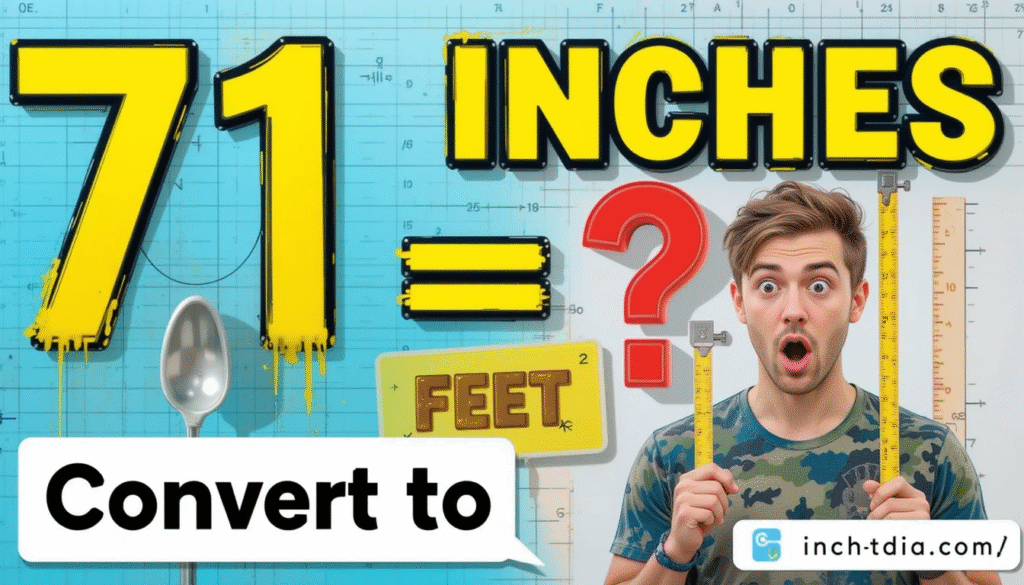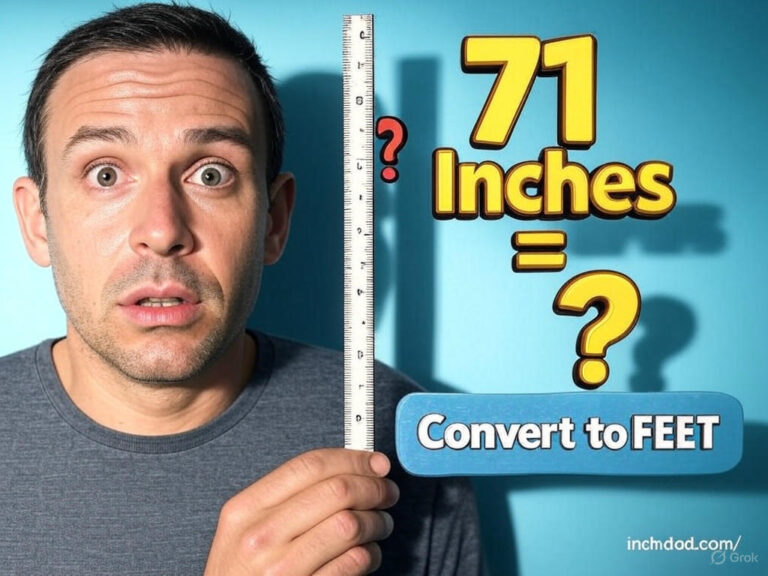Whether you’re measuring a wall for a new painting, checking your height, or planning a furniture layout, knowing how to convert 71 inches to feet is a handy skill.
The process is simple, but understanding the nuances can make your measurements more accurate and your projects more successful.
In this measurement guide, we’ll walk you through every step of the inches to feet conversion, explore practical applications, and share tips to ensure you get it right every time.
By the end, you’ll be confident in converting measurements like a pro, whether you’re transforming inches to feet manually or using a feet and inches calculator.
Understanding the Basics of Inches and Feet
What Are Inches and Feet?
Inches and feet are part of the imperial measurement system, commonly used in the United States for everyday tasks like measuring length, height, or distance.
An inch is a small unit of length, while a foot is larger, equivalent to 12 inches. This relationship is the foundation of length conversion and is critical for tasks requiring unit conversion, such as converting 71 inches to feet.
For example, think of a ruler: it’s typically 12 inches long, which equals one foot. This simple connection makes it easy to visualize how inches stack up to form feet.
Knowing this helps when you need to change 71 inches to feet or perform other measurement conversions.
Why You Might Need to Convert 71 Inches to Feet
There are countless reasons you might want to know 71 inches in feet. Maybe you’re measuring a child’s height and want to express it in feet for clarity.
Perhaps you’re working on a home renovation project and need to convert measurements to ensure materials fit perfectly.
Or maybe you’re shopping for a new couch and need to confirm it will fit in your living room. In all these cases, inches to feet conversion makes numbers easier to understand and communicate.
For instance, 71 inches equals how many feet? It’s a question that pops up in real-life scenarios, from sports to construction.
Converting to feet often simplifies discussions, especially when dealing with larger measurements where inches feel cumbersome.

The Importance of Accurate Measurement Conversion
Getting your length conversion right is crucial. A small mistake in inches to feet math can lead to buying the wrong amount of material, cutting a piece of wood too short, or misjudging a space.
Accuracy in converting 71 inches to feet ensures your projects run smoothly and your measurements are reliable.
The Step-by-Step Process to Convert 71 Inches to Feet
The Inches to Feet Formula Explained
The key to transforming inches to feet lies in a simple formula: divide the number of inches by 12. Why 12? Because there are 12 inches in one foot. The formula is:
Feet = Inches ÷ 12
This inches to feet formula is the backbone of all unit conversion tasks involving these units. Whether you’re working with 71 inches or 1000 inches, the process remains the same. Let’s apply it to convert 71 inches to feet.
Calculating 71 Inches in Feet
To find out how many feet is 71 inches, divide 71 by 12:
71 ÷ 12 = 5.9167 feet
This means 71 inches in feet is approximately 5.92 feet when rounded to two decimal places. However, in many cases, you might prefer to express the result as a combination of feet and inches, which we’ll cover next.
Example Calculation for Clarity
Let’s break down converting 71 inches to feet into feet and inches for a more practical result:
- Divide 71 by 12: 71 ÷ 12 = 5 feet (the whole number represents complete feet).
- Multiply 5 by 12: 5 × 12 = 60 inches.
- Subtract to find the remaining inches: 71 – 60 = 11 inches.
- Result: 71 inches equals how many feet? It’s 5 feet and 11 inches.
This format (5 feet 11 inches) is often more intuitive, especially for measurements like human height or furniture dimensions.
Verifying Your Unit Conversion
To ensure your length conversion is correct, reverse the process:
- Take 5 feet and multiply by 12: 5 × 12 = 60 inches.
- Add the remaining 11 inches: 60 + 11 = 71 inches.
The calculation checks out, confirming that 71 inches in feet is indeed 5 feet 11 inches. This step is especially important in tasks requiring precision, like construction or tailoring.
Handling Remainder Inches
When you change 71 inches to feet, the remainder (11 inches) is significant. In some cases, you might round 5.9167 feet to 6 feet for simplicity, but this sacrifices accuracy.
For precise tasks, always include the remaining inches or use the decimal form (5.92 feet), depending on the context.
Real-World Applications of Converting 71 Inches to Feet
Measuring Human Height
One of the most common uses of inches to feet conversion is measuring height. At 71 inches, a person is just one inch shy of 6 feet, or 5 feet 11 inches.
This measurement is typical for many adults, especially athletes or models. Knowing how many feet is 71 inches helps when filling out forms, comparing heights, or even bragging about being “almost 6 feet tall.”
For example, imagine a teenager tracking their growth. They measure 71 inches and want to know 71 inches in feet. By converting measurements, they learn they’re 5 feet 11 inches, which feels more meaningful than a raw inch count.
Home Improvement and DIY Projects
In home improvement, length conversion is a daily necessity. Suppose you’re installing a new curtain rod, and the window is 71 inches wide.
To buy the right rod, you might need to know 71 inches equals how many feet. Converting to 5 feet 11 inches helps you visualize the size and choose a rod that fits perfectly.
Another scenario: you’re laying flooring and need to calculate how many planks fit across a 71-inch space. By transforming inches to feet, you can better estimate material needs and avoid costly mistakes.
Furniture and Space Planning
When buying furniture, converting 71 inches to feet is invaluable. Imagine shopping for a sofa that’s 71 inches long. Is that too big for your living room?
By converting to 5 feet 11 inches, you can compare it to your room’s dimensions and ensure a good fit.
Space planning also benefits from quick length conversion. If your room is 10 feet long, a 5-foot-11-inch sofa leaves about 4 feet of space, which you can use for other furniture or walkways.
Sports and Equipment Measurements
In sports, unit conversion is critical. A basketball player’s height of 71 inches (5 feet 11 inches) might determine their position on the team.
Similarly, equipment like a gymnastics beam or a hockey goal might require inches to feet math to ensure compliance with regulations. Knowing how to convert 71 inches to feet ensures accurate setups and fair play.

Tips for Mastering Inches to Feet Conversion
Using a Feet and Inches Calculator
For those who prefer speed, a feet and inches calculator is a lifesaver. These online tools let you input 71 inches and instantly get 5 feet 11 inches or 5.92 feet. They’re perfect for quick checks during busy projects.
To use one, simply type “71 inches” into the calculator, select “feet” as the output, and hit calculate. The result is instant, saving you from manual inches to feet math.
Manual Quick Length Conversion Tricks
If you don’t have a calculator handy, memorize this: 12 inches equals 1 foot. For 71 inches in feet, estimate by dividing 71 by 12 mentally.
You’ll get close to 6 feet, then adjust for the remainder. Practice this, and quick length conversion becomes second nature.
Another trick: break it down. Think of 71 inches as 60 inches (5 feet) plus 11 inches. This mental shortcut speeds up converting measurements without a calculator.
Ensuring Precision in Inches to Feet Math
Precision matters in length conversion. Use a calculator for exact decimal results (like 5.9167 feet). Write down each step to avoid mistakes, especially when transforming inches to feet for critical tasks like engineering or carpentry.
Common Pitfalls in Length Conversion
Mixing Up Units
A common error is confusing inches with feet. If you accidentally divide feet by 12 instead of inches, your unit conversion will be way off. Always double-check that you’re starting with inches when converting 71 inches to feet.
Errors in Rounding
Rounding 5.9167 feet to 6 feet might seem harmless, but it can cause problems in precise tasks. For example, in construction, an extra inch could mean a piece doesn’t fit. Stick to inches to feet formula accuracy unless rounding is explicitly okay.
Forgetting to Account for Remainder Inches
When you change 71 inches to feet, don’t ignore the 11 inches left after 5 feet. Forgetting the remainder can lead to incomplete measurements, especially in tasks like cutting fabric or measuring a room.
Tools to Simplify Converting Measurements
Online Tools for Unit Conversion
Websites like ConvertUnits.com or CalculatorSoup.com offer free tools to convert 71 inches to feet. These are user-friendly and provide instant results, making them ideal for beginners and pros alike.
Mobile Apps for Measurement Conversion
Apps like Unit Converter or ConvertPad let you perform length conversion on the go. Download one, enter 71 inches, and get 5 feet 11 inches in seconds. These apps are great for fieldwork or shopping trips.
Printable Conversion Charts
For offline use, print a chart listing common inches to feet conversions. Keep it in your toolbox or workspace for quick reference. For example, a chart might show that 71 inches equals how many feet (5 feet 11 inches), saving you time.
Frequently Asked Questions About 71 Inches in Feet
How Many Feet Is 71 Inches?
71 inches in feet is 5 feet 11 inches or approximately 5.92 feet when expressed as a decimal.
71 Inches Equals How Many Feet?
Using the inches to feet formula, 71 inches equals 5 feet 11 inches. This can also be written as 5.9167 feet before rounding.
Can I Transform Inches to Feet Without a Calculator?
Yes! Divide 71 by 12 to get 5 feet, then subtract 60 inches (5 × 12) from 71 to find 11 inches. The result is 5 feet 11 inches.
How to Change 71 Inches to Feet in Seconds
For a quick length conversion, estimate: 71 ÷ 12 is about 5.9 feet. For precision, use a feet and inches calculator or the manual method above.
Conclusion
Mastering how to convert 71 inches to feet is easier than it seems. Use the inches to feet formula (divide by 12), verify your work, and account for the remaining inches.
Whether you’re measuring height, planning a project, or buying furniture, this skill ensures accuracy and confidence in converting measurements.
Read More..

